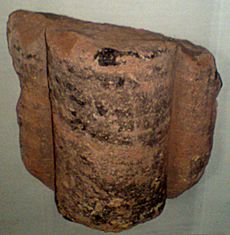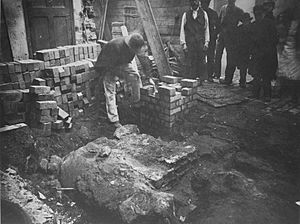Priory of St Thomas of Canterbury, Birmingham facts for kids
The Priory or Hospital of St Thomas of Canterbury was a special kind of religious house in medieval Birmingham. It was home to Augustinian canons, who were like priests living together under a set of rules.
This place was called both a priory and a hospital. In those times, these roles often mixed. Monasteries were expected to help people who were poor, sick, or traveling.
The priory was located north of Bull Street. This street was once called Chapel Street, named after the priory's chapel of St Mary. The priory owned a large area of land. This land stretched all the way to the Prior's rabbit farm, known as a conygre. Today, Congreve Street near Chamberlain Square marks where this rabbit farm once was.
We don't know the exact year the priory started. However, many old records suggest that a member of the important de Birmingham family founded it.
Contents
Early Days of the Priory

The first official mention of the priory was in 1286. At this time, some local landowners were allowed to give their property to the priory. This was done through a special legal process called mortmain, which meant the land would stay with the church forever.
In 1310, the priory received a pardon. This was because they had not properly registered 33 other land donations. This shows that the priory was doing very well and growing at that time.
Challenges and Changes
However, in 1344, the priory faced some problems. A special visit, called a visitation, checked how it was being managed. The visitors found many things that needed to be improved.
The Bishop of Lichfield then made many changes to fix these issues. These changes seemed to work well. After this, the priory received even more gifts and donations. One important gift helped set up a chantry in its chapel. A chantry was a special fund to pay a priest to say prayers for someone's soul after they died.
The End of the Priory
The Priory of St Thomas of Canterbury was closed down in 1536. This happened during a time known as the dissolution of the monasteries. The king at the time, Henry VIII, decided to close many smaller religious institutions across England.
The priory's chapel managed to stay open for another ten years. It continued to support its chantry. But in 1546 or 1547, the chapel was also closed.
After the priory and its chapel were dissolved, their land was sold off. This area was then redeveloped and became what is now known as Old Square.
Discoveries and Debates
When the priory's land was developed for houses in the 1700s and 1800s, many human bones were found. Some bones were even found south of Bull Street. This might mean there was another burial ground there. Or it could mean that Bull Street itself used to be further south.
Some historians believe these findings suggest that the priory's chapel might have been Birmingham's very first church. They think it might have existed even before St Martin in the Bull Ring. However, other historians are not so sure about this idea.


